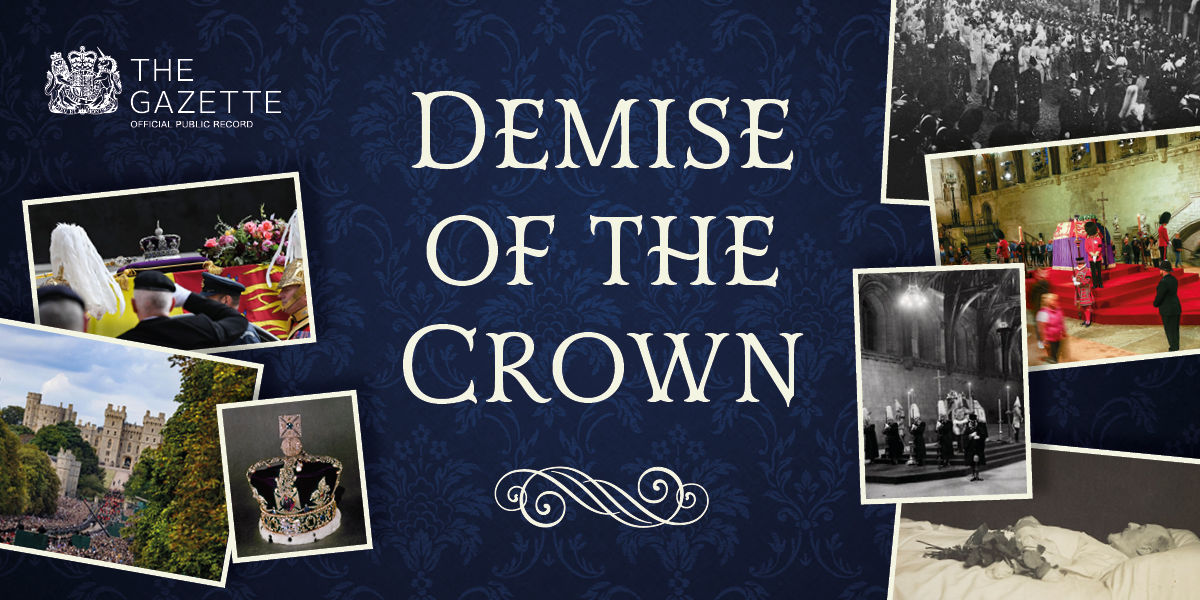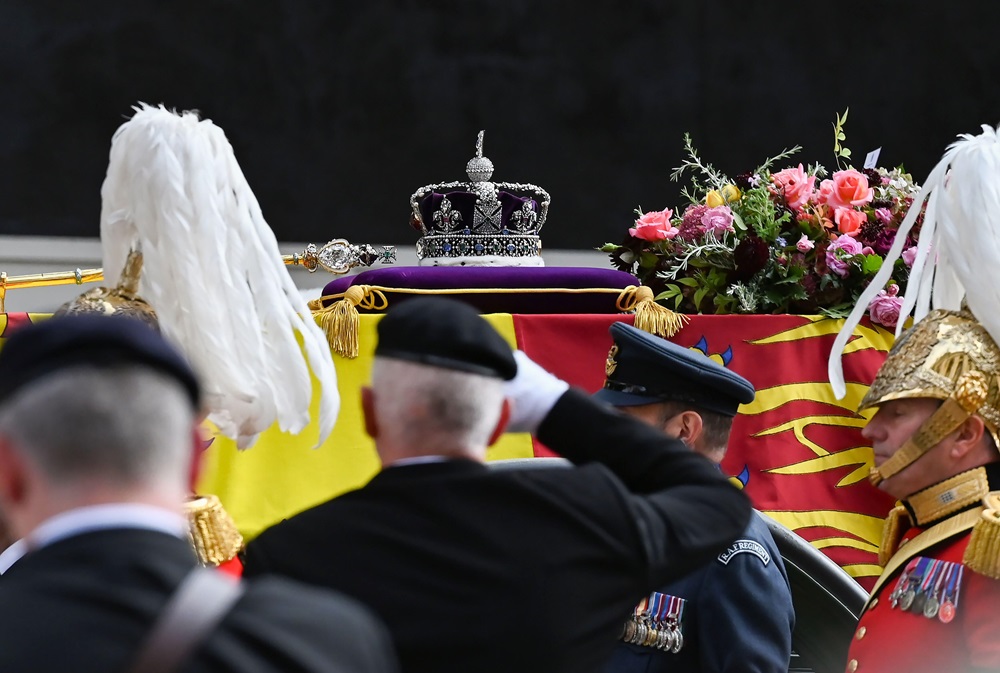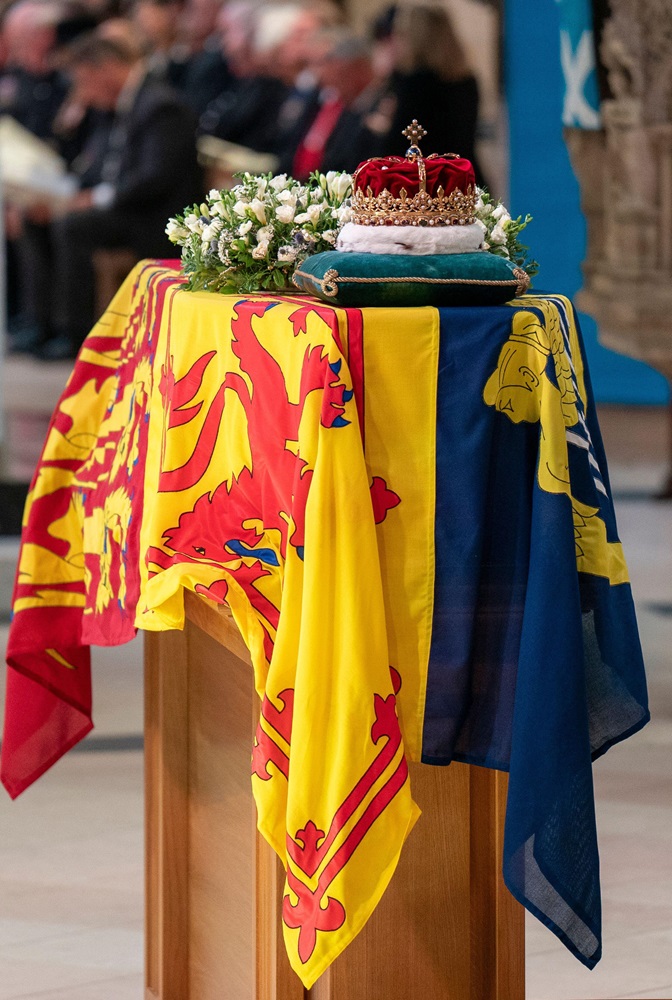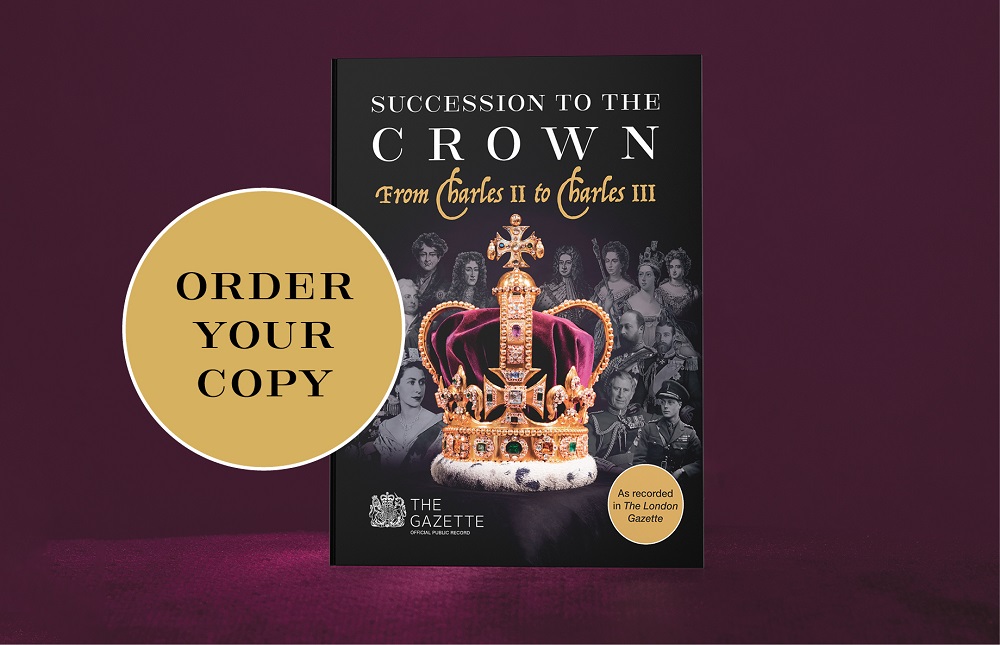Demise of the Crown: King Charles II

As the official public record since 1665, The Gazette has been recording the deaths of monarchs for over three centuries. As part of our ‘Demise of the Crown’ series, historian Russell Malloch looks through the archives at The Gazette’s reporting of events following the demise of King Charles II.
Chapters
Demise of the King
The Gazette’s earliest account of a funeral that followed a demise of the crown appeared in February 1685 following the demise of Charles II, and was preceded by the publication of the first in a continuing series of orders that were issued by the Duke of Norfolk, in his role as the earl marshal, to mark the solemn occasion.
One of the preliminary acts that followed the death of the sovereign was to determine the measures to be taken at court, and more generally by the public, to regulate what should be done to mourn the loss. The earl marshal’s directive of 9 February 1685, noted that the new sovereign, James II, had been pleased “to command me to take care that this present mourning may be performed with that decency that becomes so great an occasion.” He therefore informed “all persons concerned”:
“that ‘tis expected they put themselves into the deepest mourning that is possible; (long cloaks only excepted) and that as well all lords, as privy councillors, and officers of His late Majesty’s, and now Majesty’s household, do cover their coaches, and chairs, and clothe their livery servants with black cloth; and that none presume to use any varnish’d or bullion nails to be seen on their coaches or chairs; except His Majesty, the Queen Consort, Queen Dowager, and their Royal Highnesses.” (Gazette issue 2007)
The Gazette did not report any similar orders being made by the officials who were responsible for state ceremonial in what was then the separate kingdoms of Ireland and Scotland, where the earl marshal is unlikely to have been able to exercise his authority.
After regulating what now seems like such prosaic matters as the decoration of coaches, sedan chairs and servants’ uniforms, a few days later The Gazette explained that the remains of Charles II were conveyed to Westminster Abbey, and that his body:
“was carried under a velvet canopy, born by gentlemen of the Privy Chamber, six earls supporting the pall. The proceeding began with servants to the nobility, their Royal Highnesses, their present Majesties, the Queen Dowagers, and the late King’s servants, &c. After whom followed barons, bishops, and others of the nobility according to their respective degrees, together with the great officers, and the lord archbishop of Canterbury. His Royal Highness the Prince of Denmark was chief mourner, (his train born by the Lord Cornbury:) The supporters to the chief mourner were the Dukes of Somerset and Beaufort, wearing their collars of the Order, (as the other knights of the Garter, then present, did.) The assistants to the chief mourner were sixteen earls. One of the kings of arms carried the crown and cushion, the rest of the officers of arms attending and directing the ceremonies, which was closed with His Majesties Band of Gentlemen Pensioners, and the Yeoman of the Guard.

At the entrance into the church the dean and prebendaries of Westminster, attended with the quire, met the body, and proceeded to King Henry the Seventh’s Chappel, where it was interred in a vault under the east end of the South Isle. Service being ended, and the officers of His Majesties household having broken their staves, the royal stile was proclaimed by another of the kings of arms according to custom.” (Gazette issue 2008)
The reporter made no reference to the King’s remains being accompanied by a wax effigy, of the kind that was made for the Duke of Albemarle in 1670, and most of the royal funeral accounts from the first half of the 18th century do not notice their use. An effigy was, however, created for Charles II shortly after his death, and showed the sovereign standing in his Garter robes, complete with a plumed hat and elaborate under-dress. The effigy is reported to have been displayed in a showcase near his grave for more than a century, before being moved to different locations within Westminster Abbey, most recently to the Queen’s Diamond Jubilee Galleries in the abbey.
Demise and succession
The relationship between a demise of the crown and a succession to the crown was obvious from The Gazette’s accounts of the proceedings connected with the transfer of the royal authority in April 1685, when the dean and prebendaries of Westminster who met the remains of Charles II in February, and the dukes of Beaufort and Somerset who supported Prince George of Denmark as the chief mourner, now took part in the coronation of King James and Queen Mary (Gazette issue 2028).
The ceremonial for the inauguration of the new sovereign described how the dean of Westminster presented the regalia to James in Westminster Hall, and that the dukes of Beaufort and Somerset carried the Queen’s crown and the King’s orb in the procession from the hall to “the Collegiate Church of St Peter, Westminster” where the crowning ritual was performed, not far from the spot where the funeral service had taken place two months earlier.
The events of 1685 were typical of later reigns, as the peers, clergymen and others gathered first at Westminster Abbey to pay their respects to the late monarch, and shortly afterwards they assembled to pay homage to the new sovereign. The funeral and coronation rituals were separated by a short period, and sometimes only a few weeks, until after the end of the 18th century, after which a year or more elapsed between the ceremonies and tended to reflect the more settled state of the nation that had evolved.
Royal precedent
Most of the ingredients from the 1685 ritual were present in the programmes for later royal funerals, as evidenced by the fact that in 2022 the passing of Elizabeth II involved:
- a procession of the royal remains to Westminster Abbey
- a ritual devised by the Church of England
- the coffin accompanied by pall bearers
- the role of a chief mourner
- the display of regalia
- the presence of great officers of state
- the attendance of the officers of arms and royal body guards
- the proclamation of the royal style and titles by Garter king of arms
- the surrender of an emblem of office by a senior member of the household
The differences in the arrangements as between 1685 and 2022, based on the narrative in The Gazette, were fewer and included:
- the timing of the ceremony, as the funerals of Charles II and his successors, through to William IV in 1837, were held at night, and with the aid of candlelight and flaming torches
- the absence of places in the cavalcade for barons, bishops and other noblemen (although peers continued to walk in the procession if they held offices that were relevant to the ritual, as with the lord chamberlain and lord steward)
The fashion for wax effigies was also long past, but for a time the earl marshal continued to issue orders to regulate the appearance of the coaches, chariots and sedan chairs that were used by privy counsellors and officers of the royal household.

Funeral arrangements
As regards the links that exist between 1685 and 2022, the role of the chief mourner was usually given to a senior family member. In 1685 the position was held by Prince George of Denmark (Duke of Cumberland), who was the husband of the King’s niece Anne. The Danish prince performed a similar role for William III in 1702, while the Duchess of Ormonde mourned the loss of Queen Anne in 1714.
For George II and George III, the chief mourners were the King’s sons, William, Duke of Cumberland, in 1760, and Frederick, Duke of York, in 1820. The new sovereign performed the task for the first time in 1830, when William IV acted for his brother, but seven years later it was another brother Augustus, Duke of Sussex, who played that role after William’s death. The new monarch acted as the chief mourner at all four of the 20th century’s funerals, as did King Charles III in 2022.
The sovereign’s casket was usually covered by a pall and/or canopy. Until the middle of the 19th century the pall bearers were usually dukes, and so peers of the highest rank, while the canopy was often supported by more junior peers. Starting with the service for Queen Victoria in 1901 the monarch’s pall bearers have usually been equerries, or other relatively junior members of the late sovereign’s household.
The names of the pall bearers were first gazetted for a royal funeral in 1737, when Queen Caroline’s body was covered with a pall of black velvet, and accompanied by the dukes of Argyll, Kent, Monmouth and Richmond, each wearing their collars as knights of the Garter, along with the dukes of Buccleuch and St Albans with their collars of the Thistle and Bath (Gazette issue 7660).
The insignia of the orders of knighthood was routinely put on display during royal obsequies, and The Gazette occasionally advised its readers about the costume that was worn, as with the ceremony to commemorate the death of George II in 1760 when the programme explained “The knights of the Garter, Thistle, and Bath, who walk in this procession, are to wear the collars of their respective orders” (Gazette issue 10049). The emblems of the Garter, in particular, became one of the most enduring images in this context, as evidenced by the fact that the blue riband and cross of St George were seen at Elizabeth II’s funeral in 2022, when Charles III, the kings of Spain and Sweden and others wore the Garter’s riband and star.
Parts of the regalia were routinely brought into the funeral ritual, with the imperial crown being carried before the coffin by one of the kings of arms. Provision was made for Hanoverian regalia to be used for this purpose after the formation of that kingdom during the Regency, with the result that the crown of Hanover was displayed along with the imperial crown of the United Kingdom at the sovereign’s funerals in 1820, 1830 and 1837.

The procedure for displaying the regalia changed after Victoria’s succession to the crown in 1837, as the Hanoverian kingdom had passed out of her control, and when she died in 1901 the single imperial state crown, along with a sceptre and orbs, were placed on her casket, rather than being carried by one of the officers of arms.
The crown of Scotland did not feature in any arrangements after a demise of the crown until 2022, when the 16th century emblem was placed on Elizabeth II’s coffin in St Giles’ Cathedral in Edinburgh, as part of the preliminary state service that was organised following her death at Balmoral Castle in Aberdeenshire.
In addition to the duty of carrying the crown, the officers of arms were responsible for other aspects of the ceremonial. Under the direction of the earl marshal, the senior member of the College of Arms, who was also the king of arms of the Order of the Garter, usually walked in the procession immediately after the coffin, and before the chief mourner, and was responsible for proclaiming the late sovereign’s style and titles, as he did in 1685 and in 2022.
The common areas of the programme to mark the demise of the crown, and the changes that were introduced between 1685 and 2022, are examined in more detail in the articles that follow.
Demise of the Crown
In addition to the funeral ritual, other matters connected with the demise of the crown were noticed in The Gazette, including the first official act of King James II to be placed in the public record in 1685, which was a proclamation to ensure that the administration of the realm would continue without interruption, despite his brother’s death “by whose decease the authority and power of the most part of the offices and places of jurisdiction and government within this realm, and in the realm of Ireland did cease and fail, the sovereign person failing, from whom the same were derived”.
The proclamation stated that all persons who were “duly and lawfully possessed of, or invested in any office, or place of authority or government, either civil or military … shall be, and shall hold themselves continued in the said places and offices, as formerly they held and enjoyed the same, until His Majesty’s pleasure be further known.” (Gazette issue 2006)
The demise of the crown triggered the end of the current session of parliament, and steps had to be taken to hold a new election, and to secure the flow of the revenues that were needed to pay for the business of the crown and the government.
The cumbersome procedures that followed a demise were gazetted for generations after 1685, and it was not until 1867 that the Representation of the People Act provided that “the parliament in being at any future demise of the crown shall not be determined or dissolved by such demise” (Gazette 23292). The effect of this act was not felt until January 1901, when the existing parliament did not come to an end when Queen Victoria expired.
As regards the continuity of offices, the Demise of the Crown Act that was passed in July 1901 stated that “the holding of any office under the crown, whether within or without His Majesty’s dominions, shall not be affected, nor shall any fresh appointment thereto be rendered necessary, by the demise of the crown.” (Gazette issue 27330)

Succession to the Crown: From Charles II to Charles III
Succession to the Crown is essential reading for anyone with a keen interest in the British royal family and provides an excellent and trusted source of information for historians, researchers and academics alike. The book takes you on a journey exploring the coronations, honours and emblems of the British monarchy, from the demise of King Charles II in 1685, through to the accession of King Charles III, as recorded in The London Gazette.
Historian Russell Malloch tells the story of the Crown through trusted, factual information found in the UK's official public record. Learn about the traditions and ceremony engrained in successions right up to the demise of Queen Elizabeth II and the resulting proclamation and accession of King Charles III.
Available to order now from the TSO Shop.
About the author
Russell Malloch is a member of the Orders and Medals Research Society and an authority on British honours. He authored Succession to the Crown: From Charles II to Charles III, which explores the coronations, honours and emblems of the British monarchy.
See also
King Charles III and The Gazette
Gazette Firsts: The history of The Gazette and monarch funerals
Find out more
Succession to the Crown: - From Charles II to Charles III (TSO shop)
Images
The Gazette
Getty Images
Simon Dack News / Alamy Stock Photo
PA Images / Alamy Stock Photo
The Gazette
Publication date
7 October 2024
Any opinion expressed in this article is that of the author and the author alone, and does not necessarily represent that of The Gazette.
